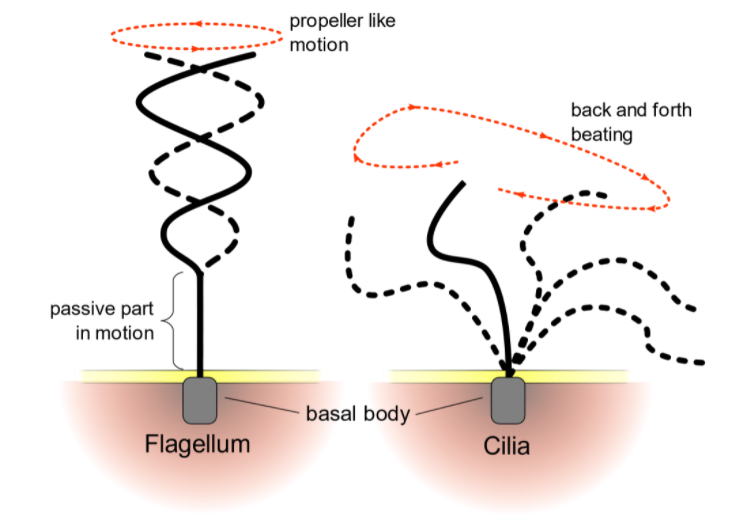
What structural and functional characteristics do cilia, flagella and centrioles have in common?
Answer
364.2k+ views
Hint: Cilia and flagella are cell extensions. They are composed of microtubules and covered by an extension of the plasma membrane, as depicted in this animation. Flagella and centrioles are motile and are designed to move the cell or substances over or around it. The microtubules that make up centrioles and flagella are similar. Two rings of nine microtubule "triplets" are positioned at right angles to one another in centrioles. Flagella do not have this configuration.
Complete solution:
Cilia in mammalian cells serve to transfer fluid, mucus, or cells over their surface. The internal structure of cilia and flagella is identical. The main distinction is in their length. Cilia and flagella move because of the interactions of a set of microtubules inside. Collectively, these are called an "axoneme".
Flagella and cilia have the same axoneme structure, with nine doublet microtubules organized in a circle around two central singlet microtubules, despite their differing names. Centrioles, like cilia and flagella, are made up of microtubules. Centrioles are microtubule-based hollow cylinders.

Centrioles assist in the organization of the microtubules that transport chromosomes during cell division, ensuring that each daughter cell receives the correct number of chromosomes.
The primary function of cilia and flagella is movement. They are the means by which many microscopic unicellular and multicellular organisms move from place to place. Many of these organisms are found in aqueous environments, where they are propelled along by the beating of cilia or the whip-like action of flagella.re also necessary for the production of cilia and flagella, which are cell structures.
Note:
Centrioles, which travel to the cell's edge, organize cilia and flagella. The direction of movement is governed by basal bodies. The cilia or flagella movement is controlled by centrioles. The mother centriole, which becomes the basal body in flagellates and ciliates, determines the position of the flagellum or cilium. A number of hereditary and developmental illnesses have been connected to cells' failure to employ centrioles to create functional flagella and cilia.
Complete solution:
Cilia in mammalian cells serve to transfer fluid, mucus, or cells over their surface. The internal structure of cilia and flagella is identical. The main distinction is in their length. Cilia and flagella move because of the interactions of a set of microtubules inside. Collectively, these are called an "axoneme".
Flagella and cilia have the same axoneme structure, with nine doublet microtubules organized in a circle around two central singlet microtubules, despite their differing names. Centrioles, like cilia and flagella, are made up of microtubules. Centrioles are microtubule-based hollow cylinders.

Centrioles assist in the organization of the microtubules that transport chromosomes during cell division, ensuring that each daughter cell receives the correct number of chromosomes.
The primary function of cilia and flagella is movement. They are the means by which many microscopic unicellular and multicellular organisms move from place to place. Many of these organisms are found in aqueous environments, where they are propelled along by the beating of cilia or the whip-like action of flagella.re also necessary for the production of cilia and flagella, which are cell structures.
Note:
Centrioles, which travel to the cell's edge, organize cilia and flagella. The direction of movement is governed by basal bodies. The cilia or flagella movement is controlled by centrioles. The mother centriole, which becomes the basal body in flagellates and ciliates, determines the position of the flagellum or cilium. A number of hereditary and developmental illnesses have been connected to cells' failure to employ centrioles to create functional flagella and cilia.
Recently Updated Pages
Glucose when reduced with HI and red Phosphorus gives class 11 chemistry CBSE

The highest possible oxidation states of Uranium and class 11 chemistry CBSE

Find the value of x if the mode of the following data class 11 maths CBSE

Which of the following can be used in the Friedel Crafts class 11 chemistry CBSE

A sphere of mass 40 kg is attracted by a second sphere class 11 physics CBSE

Statement I Reactivity of aluminium decreases when class 11 chemistry CBSE

Trending doubts
The reservoir of dam is called Govind Sagar A Jayakwadi class 11 social science CBSE

10 examples of friction in our daily life

Difference Between Prokaryotic Cells and Eukaryotic Cells

State and prove Bernoullis theorem class 11 physics CBSE

Proton was discovered by A Thomson B Rutherford C Chadwick class 11 chemistry CBSE

State the laws of reflection of light




